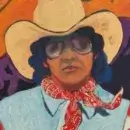
Tommy Wayne “T. C.” Cannon, Pai-doung-a-day (One Who Stands in the Sun)
Tommy Wayne “T. C.” Cannon, Pai-doung-a-day (One Who Stands in the Sun), was a Native American artist, popularly known as T. C. Cannon. An enrolled member of the Kiowa Indian Tribe of Oklahoma with Caddo and French ancestry, he was a leader among the first group of Native artists whose work addressed the tensions of being a modern Native in an Anglo-dominated world. His artistic works represent a turning point of Indian painting in post–World War II America, representing a shift from earlier “Flatstyle,” two-dimensional traditional painting on paper and canvas surfaces. Cannon’s work was characterized by his use of bold colors, dynamic composition, and insightful cultural commentary on Native identity in the modern world.
He grew up in southern Oklahoma, and was heavily influenced by Stephen Mopope and other members of the “Kiowa Six,” a group of Native American painters who achieved international reputations and helped develop the Southern Plains–style of painting. Cannon was educated at the Institute of American Indian Arts (IAIA) in Santa Fe, New Mexico (diploma, 1966), San Francisco Art Institute, and Central State University (now the University of Central Oklahoma; B.A., 1972).
In 1966, Cannon enlisted in the U.S. Army and served in Vietnam as a paratrooper in the 101st Airborne Division through 1968. He received a Bronze Star for valor during the Tet Offensive and other commendations for his actions. His experiences of war influenced his work. In 1972, Cannon and his former IAIA teacher Fritz Scholder had a two-person show at the Smithsonian’s National Museum of American Art. The following six years were his most productive, and he was scheduled for his first one-person show at Aberbach Gallery in New York when he died in an automobile accident. The exhibition opened in December 1979 as T. C. Cannon: A Memorial Exhibition and traveled to museums around the country.
As a masterful interpreter of the complex Native American experience, Cannon’s work continues to influence artists and other creative spirits. His works are held by the Gilcrease Museum in Tulsa, the Southern Plains Indian Museum in Anadarko, the National Cowboy and Western Heritage Museum in Oklahoma City, the Institute of American Indian Arts in Santa Fe, and numerous private collections.